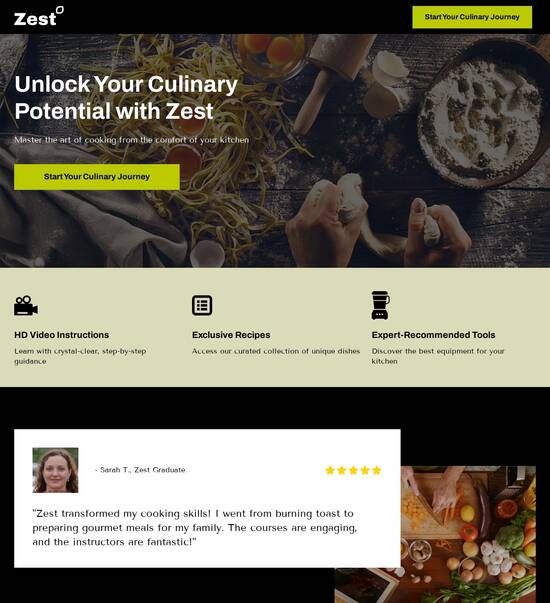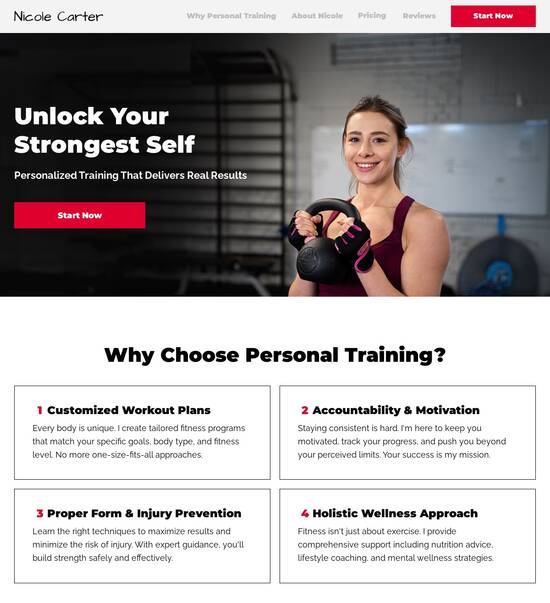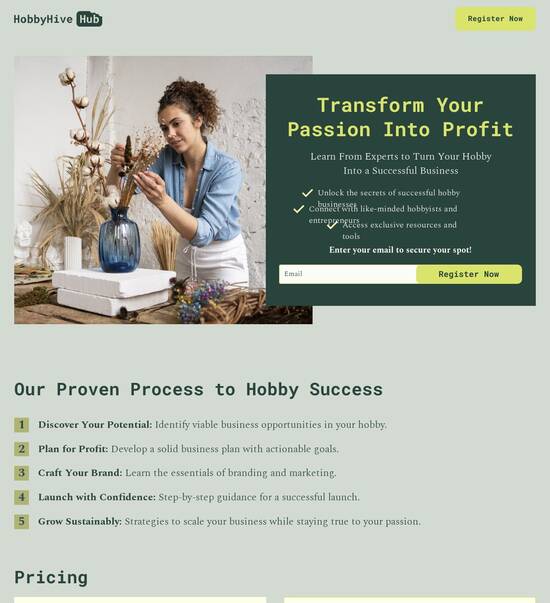
Blog page template for theatre companies
Explore Similar TemplatesAbout template
Reach out to the right audience with blog page template for theatre companies
Recommended templates

Easy to build without coding
With the intuitive drag-and-drop builder, anyone on your team can create high-converting pages without any knowledge of code or design. Make enhancements to your landing page with custom widgets using Javascript, HTML/CSS, or third-party scripts.

Multiple layouts for any industry and goal
Select from 500+ landing page layouts built to boost conversions across industry-specific scenarios. Customize them by adjusting fonts, adding images, and generating on-brand content with the AI assistant. Quickly scale with Instablocks® and Global Blocks that you can save, reuse, and update globally.

Loads fast and looks polished on any device
Every template is responsive, which means they present professionally on any device and load blazingly fast with our Thor Render Engine. You can also power them up with Google AMP technology to deliver an unparalleled mobile experience and drive higher conversions.

Robust analytics & experimentation
Get real-time updates and reporting across all your devices, showing the number of visitors, conversions, cost-per-visitor, and cost-per-lead. Launch AI-powered experiments, run A/B tests, and use heatmaps to analyze user behavior, then optimize your landing page to maximize conversions.







Easy to build without coding
With the intuitive drag-and-drop builder, anyone on your team can create high-converting pages without any knowledge of code or design. Make enhancements to your landing page with custom widgets using Javascript, HTML/CSS, or third-party scripts.
Multiple layouts for any industry and goal
Select from 500+ landing page layouts built to boost conversions across industry-specific scenarios. Customize them by adjusting fonts, adding images, and generating on-brand content with the AI assistant. Quickly scale with Instablocks® and Global Blocks that you can save, reuse, and update globally.
Loads fast and looks polished on any device
Every template is responsive, which means they present professionally on any device and load blazingly fast with our Thor Render Engine.
Robust analytics & experimentation
Get real-time updates and reporting across all your devices, showing the number of visitors, conversions, cost-per-visitor, and cost-per-lead. Launch AI-powered experiments, run A/B tests, and use heatmaps to analyze user behavior, then optimize your landing page to maximize conversions.
All the features you need to build lead-generating landing pages
Explore more featuresLearn how to build top-performing landing pages for any goal
FAQs
Leading the way in building high-performing landing pages





An essential guide to using Instapage for creating high-converting landing pages in the USA
For marketers in diverse sectors such as business services, tech, education, and financial services, leveraging a powerful landing page and conversion rate optimization (CRO) platform like Instapage is crucial. This guide will walk you through the process of maximizing your digital marketing campaign's ROI through effective landing page strategies.
Understanding the power of Instapage
Instapage stands out as a top-choice landing page creator because of its robust features. With over 100 conversion-focused templates, users can effortlessly build and launch pages tailored to their specific audiences. This flexibility is especially appealing to marketers across various verticals who need fast yet effective solutions.
- Customization with ready-to-use templates: Instapage offers a variety of templates designed for conversion, making it easy to tailor your campaign's landing page to specific audience needs.
- Instant lead generation options: Our pre-built lead generation elements allow marketers to capture vital information seamlessly, improving potential conversions.
- Collaboration features for team efficiency: Instapage enables real-time feedback and edits, ensuring teams can rapidly create and optimize landing pages.
Step 1: Selecting the Right Template
Choosing the right template is the first essential step. With Instapage's vast library, find a layout that aligns with your campaign goals. Focus on templates optimized for leads in your particular market segment.
Step 2: Optimization Features
The optimization process involves A/B testing and heatmaps, critical for identifying what elements engage users effectively. Integrating your analytics will allow you to make informed decisions for continuous improvement.
- A/B testing: This feature helps you compare different versions of your landing page to determine which one resonates more with your audience.
- Heatmaps: Understand user behavior on your page, showing where visitors click most frequently, allowing for better placement of CTAs.
- Analytics dashboard: Monitor performance metrics in one place to easily track user interactions and conversion rates.
Step 3: Personalizing Your Landing Pages
Personalization is key in today’s digital marketing landscape. With Instapage, you can dynamically change text and visuals based on audience data, ensuring a tailored experience that speaks directly to different user segments.
- Dynamic text replacement: This feature allows you to adjust copy based on the traffic source or audience needs, enhancing relevance.
- AdMaps: Align your PPC ads with specific landing pages to ensure a cohesive message throughout the customer journey.
- Metrics tracking: Measure how each variant performs with real-time data, providing insights to further refine your audience targeting.
In conclusion, leveraging Instapage for your landing page strategies equips you with necessary tools to enhance your digital marketing effectiveness substantially.
Start transforming your campaigns today by creating a free Instapage account and exploring how our landing page solutions can work for you.
Unveiling the perfect blog page template for theatre companies
Understanding the core needs of theatre companies
Theatre companies today find themselves in an increasingly digital landscape, where an influential online presence can make a substantial difference to their visibility. Every theatre's goal is to connect with audiences and engage them before they even step foot into the venue. A well-structured blog is an essential tool for achieving this aim, as it not only serves to promote productions but also fosters community. Given the rich history and the passionate crowd that surrounds theatre, leveraging a dedicated blog can amplify brand reach and create a more intimate connection with audience members.
Understanding the primary features a blog must have is crucial for its success. Firstly, the blog should effectively promote events and provide timely updates about performances, casting, and ticket availability. Secondly, it should have storytelling capabilities that allow theatre companies to share behind-the-scenes experiences, anecdotes from artists, or discussions on the thematic relevance of their plays. Most importantly, a space for audience interaction—through comments, shares, and social media engagement—is critical as it helps build a vibrant community around the theatre.
Foundational elements of a theatre company blog page
When selecting a blog page template, theatre companies need to ensure it includes key foundational components. The header is the first point of contact, where the logo design must reflect the theatre's brand identity and artistic vision. Next, a user-friendly navigation bar is essential, allowing visitors to quickly find performances, ticket options, and important updates. Additionally, a featured posts section should highlight current and upcoming productions, ensuring that content is accessible and immediately engaging to new visitors.
Beyond functionality, theme selection plays a crucial role in enhancing representation. A well-chosen color scheme can reflect the theatre’s brand identity and create an emotional connection with audiences. Likewise, fonts should resonate with the character of the theatre, whether it be classic elegance or modern boldness, ensuring that the textual presentation aligns with overall branding.
Harnessing the power of template features
Customizing layout options within a blog template allows theatre companies to tailor their displays according to audience preferences. A decision between grid and list view will influence how information is perceived; for instance, a grid view can showcase visually appealing images of performances, while a list view offers straightforward access to the latest updates. Dynamic content blocks can also be employed to effectively highlight different genres or special themes, giving visitors a fresh perspective each time they visit.
Moreover, integrated media capabilities are vital for a theatre blog's success. High-quality image galleries that capture the essence of performances can engage the audience on a visual level. Video embeds are increasingly popular as they allow sharing of exclusive behind-the-scenes content or notable performances, effectively keeping fans engaged. Lastly, implementing SEO optimization tools ensures the blog ranks well in search results. Utilizing meta tags, snippets for better visibility, and integration with Google Analytics will guide theatres in understanding audience behavior and refining their content strategies.
Enhancing audience engagement
Engaging the audience extends beyond publishing content. Interactive features like comment sections not only encourage conversations but also create a sense of community. Allowing visitors to share their views about shows or performances gives a platform for feedback and connection with fellow theatre lovers. Furthermore, integrating social media channels into the blog can significantly broaden the theatre’s reach, providing instant updates and insights into productions.
An effective way to maintain ongoing engagement is by building a newsletter sign-up and a blog subscriber list. Incentives such as exclusive content, behind-the-scenes access, or discounts on tickets can motivate potential subscribers to join in. It is equally important to adopt best practices for email campaigns, ensuring consistency in communication while also tailoring messages to align with subscriber interests.
Showcasing content types and personalization
The content displayed on a theatre blog should be curated for diverse audiences, presenting various angles in a relatable way. Behind-the-scenes comic hooks can intrigue fans and create a more profound connection with the performances. Spotlighting cast and crew members adds a personal touch, allowing audiences to learn more about the people who bring their favorite stories to life and fostering deeper appreciation for the art.
The creation of a shortlist of content ideas can help streamline blog posts throughout the year. Seasonal posts, such as holiday-themed shows or summer specials, keep the blog relevant and time-sensitive. Additionally, audience feedback posts, where opinions on past shows or suggestions for future performances are discussed, can play a significant role in crafting relevant content that appeals directly to audience preferences.
Prototyping and implementation: starting to build
When it comes time to build a blog page, selecting the right web designers who can encapsulate your theatre's vision is key. Effective theatre website developers should possess a strong portfolio showcasing innovative and user-friendly designs. Working within a budget can also guide decisions between custom versus template solutions. It's worth evaluating whether investing in a custom design will yield long-term benefits over a more affordable template option.
In the customization process, following a structured approach will go a long way. Start by selecting a platform that aligns with your needs, such as a focus on media integration and audience interaction. Enhancing user experience should remain a priority—ensure that the design is intuitive, making it easy for visitors to navigate. Finally, iterating based on user feedback allows for continual refinement and fostering a welcoming online atmosphere.
Case studies: successful theatre blogs as examples
Exploring engaging theatre company blogs provides valuable insights that new companies can leverage. Noteworthy blogs often exhibit features that stand out, such as interactive elements that promote user participation or visually compelling layouts that capture the essence of their performances. Unique elements that successfully drive traffic and engagement could include a dedicated audience engagement section or exclusive multimedia content that showcases the theatre's artistic diversity.
Engaging directly with industry insiders can provide perspective on successful strategies. Conducting interviews with founders of well-regarded theatre blogs can yield insights on the challenges they faced while building their online presence and the solutions they found effective. This can serve as an encouraging blueprint for new theatre companies navigating the complexities of digital content creation without losing sight of their artistic vision.
The future of theatre company blogs
The landscape of theatre blogs is evolving along with user expectations and advances in technology. As more audiences engage with immersive experiences, the introduction of virtual and augmented reality may become increasingly common in blog content. The adaptation to such emerging technologies will be fundamental for theatres aiming to remain relevant and engaged with their audience in a constantly shifting digital age.
In conclusion, creating a lasting digital impact requires continual learning and adapting. Theatre companies should be prepared to experiment with new ideas and formats in their blog content while remaining true to their artistic mission. By fostering a community through engaging and personalized content, they can build a legacy that resonates with audiences both online and off.
Ready to skyrocket conversions?
Supercharge your ad campaigns with high-performing landing pages
Get started














